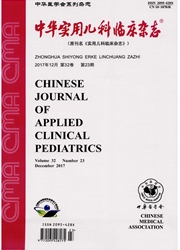

 中文摘要:
中文摘要:
目的观察NYGGF4小鼠同源基因在遗传性ob/ob肥胖小鼠(以下简称ob/ob小鼠)与正常C57/BL6J小鼠脂肪组织中的差异表达,分析NYGGF4小鼠同源基因在ob/ob小鼠体内的多组织表达特征,探讨NYGGF4小鼠同源基因与肥胖之间的关系。方法雄性10周龄ob/ob小鼠、正常小鼠(对照组)各12只,以乌拉坦(0.4g/kg)深度麻醉后取腹膜后脂肪、肝、脑、骨骼肌、心肌、结肠、肾、小肠、肺、胸腺、脾等组织,采用RT-PCR技术检测NYGGF4小鼠同源基因的mRNA表达水平,比较NYGGF4小鼠同源基因在ob/ob小鼠与正常对照小鼠腹膜后脂肪组织中的差异表达及在ob/ob小鼠各组织中的表达。结果1.ob/ob小鼠体质量[(38.94±1.97)g]显著高于对照组小鼠:(18.47±0.66)g](P〈0.001);2.NYGGF4小鼠同源基因在ob/ob小鼠腹膜后脂肪组织中的表达水平[(89.18±8.31)%]显著高于对照组小鼠[(56.84±9.54)%](P〈0.001);3.NYGGF4小鼠同源基因在肝脏、脑、腹膜后脂肪、骨骼肌、心肌、结肠、肾脏等组织中均有表达,从高至低依次为肝脏〉脑〉腹膜后脂肪〉骨骼肌〉心肌〉结肠〉肾脏,虽在小肠、肺、胸腺、脾等组织中未检测到阳性信号,但总体上呈现多组织表达特征。结论NYGGF4小鼠同源基因可能参与肥胖发生的病理生理机制,并在肝脏、脑、腹膜后脂肪、骨骼肌等胰岛素作用的靶组织中表达水平相对较高。
 英文摘要:
英文摘要:
Objective To observe the different expression of NYGGF4 murine homologous gene mRNA in retroperitoneal adipose tissue between inherited ob/ob fatty mice and normal C57/BL6J mice ( control group) , analyze the characteristic of multiple - tissue expression of NYGGF4 murine homologous gene in inherited ob/ob fatty mice and explore the relationship between NYGGF4 murine homologous gene and obesity. Methods Twelve male inherited ob/ob fatty mice and 12 normal C57/BL6J mice were deeply anesthetized with urethane (0.4 g/kg). Different expression of NYGGF4 routine homologous gene in retroperitoneal adipose tissues between inherited ob/ob fatty mice and normal C57/BL6J mice and in multiple tissues of inherited ob/ob fatty mice including retroperitoneal adipose,liver, brain, skeletal muscle, cardiac muscle, colon, kidney, small intestine,lung, thymus and spleen were detected by reverse transcriptase polymerase chain reaction( RT- PCR). Results 1. Bodyweight of inherited ob/ob fatty mice [ (38.94 ± 1.97 ) g] was significantly' higher than that of control group [ ( 18.47 ± 0.66) g ] ( P 〈 0. 001 ). 2. The expression level of NYGGF4 murine homologous gene in retroperitoneal adipose tissues of inherited ob/ob fatty mice [ ( 89.18 ± 8.31 ) % ] was found to be remarkably higher than that of control group [ (56.84 ± 9.54) % ] ( P 〈 0. 001 ). 3. The expression level of NYGGF4 murine hmnologous gene were detected respectively in 7 kinds tissues, from high to low : liver 〉 brain 〉 retroperitoneal adipose 〉 skeletal muscle 〉 cardiac muscle 〉 colon 〉 kidney. There were no positive signals detected in small intestine,lung, thymus, spleen, but overall the multiple - tissue expression was notable. Conclusions NYGGF4 murine homologous gene may be involved in the physiological mechanism of obesity,and the level of expression in such target tissues of insulin as liver, brain, retroperitoneal adipose, skeletal muscle are correspondingly higher than other tissues.
 同期刊论文项目
同期刊论文项目
 同项目期刊论文
同项目期刊论文
 Over-expression of NYGGF4 inhibits glucose transport in 3T3-L1 adipocytes via attenuated phosphoryla
Over-expression of NYGGF4 inhibits glucose transport in 3T3-L1 adipocytes via attenuated phosphoryla Identification and characterization of NYGGF4, a novel gene containing a phosphotyrosine-binding (PT
Identification and characterization of NYGGF4, a novel gene containing a phosphotyrosine-binding (PT 期刊信息
期刊信息
